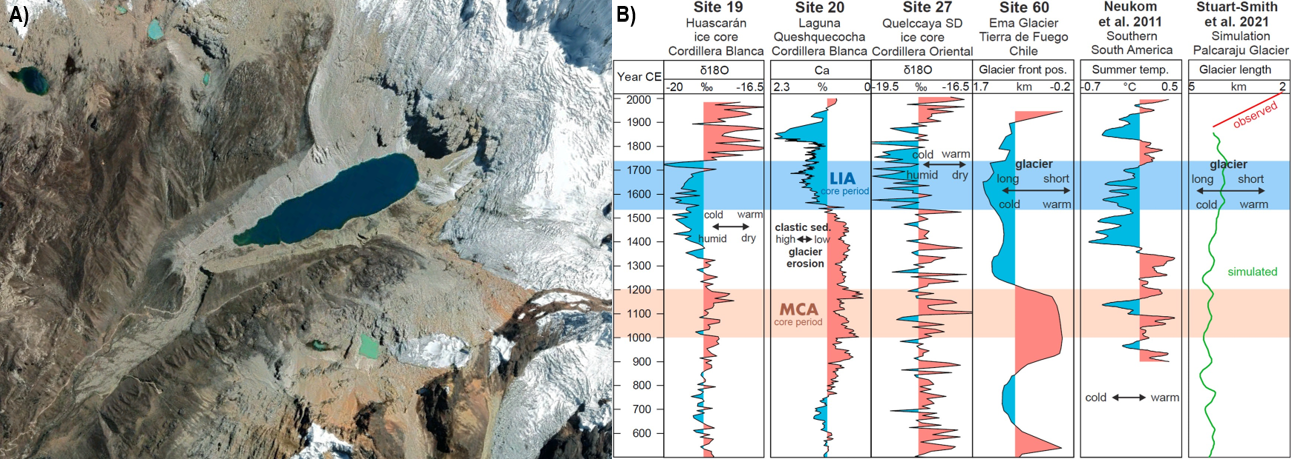- Home
- Publications
- PAGES Magazine
- The Combined Use of Paleoenvironmental Reconstructions and Glaciological Modeling For Assessing The Effect of Climatic Variability On Andean Cryospheric Environments
The combined use of paleoenvironmental reconstructions and glaciological modeling for assessing the effect of climatic variability on Andean cryospheric environments
Cinthya Bello, L. Perez, C. Torres, J. Arigony-Neto and F. García-Rodriguez
Past Global Changes Magazine
31(2)
114
2023
Dr. Cinthya Bello, from Perú, visited Centro Universitario Regional Este (CURE) - Universidad de la República de Uruguay as a PAGES-IAI (Inter-American Institute for Global Change Research) Mobility Research Fellow. From 12 March to 8 April 2023, she strengthened her knowledge in the application of paleoenvironmental science as a complementary tool to ongoing glaciological modeling for the reconstruction of past glacial environments.
An overview: periglacial system in the Peruvian Andes
The tropical Andes have been negatively impacted by hydroclimatic and socioeconomic changes in the context of global change (Drenkhan et al. 2018). In the Peruvian Andes, glaciers show significant ice loss equivalent to 1284.95 km² (53.56%) between 1955 and 1962, and during 2016 (INAIGEM 2018). In addition, recent studies confirmed the development of several high mountain lakes, as a result of glacier shrinkage (Colonia et al. 2017), which increase the glacial-lake outburst flood hazards (GLOFs). Despite the effort to develop an inventory and projection of future lake formation in the Peruvian mountain ranges, there is a lack of knowledge regarding the evolution of these periglacial systems. It is necessary to comprehensively assess their past, present, and future development under climate change scenarios to ensure sustainable water use. Therefore, paleolimnology represents a useful tool for studying periglacial systems because this interdisciplinary science uses chemical, physical, and biological information from the sedimentary record to reconstruct the environmental evolution of these systems on a millennial, secular, decadal, and interannual timescale (García-Rodriguez et al. 2009).
Thanks to the support of the PAGES-IAI Fellowship, I participated in a series of lectures dedicated to an overview of the different techniques used in paleolimnology in order to: 1) reconstruct the evolution of glacier lake systems; 2) analyze sediment cores with a multi-proxy approach for environmental reconstructions (e.g. lithology, geochemistry, dating); 3) use software for data handling, importing data and visualization (e.g. PAST, BACON); and 4) learn new approaches for the historical reconstruction of paleoenvironments (e.g. faunal remains).
In addition, the article written by Stuart-Smith et al. (2021) was discussed. This study describes a rapid expansion of the Lake Palcacocha (Fig. 1a) since the pre-industrial era, located in the city of Huaraz (department of Ancash, Perú), due to the retreat of the Palcaraju Glacier driven by the anthropogenic increase of temperature by 1°C since 1880 CE. However, Lüning et al. (2019, 2022) has also demonstrated that Andean glaciers retreated significantly during the Medieval Climate Anomaly (1000–1200 CE), a warm climate period in South America, and questioned the conclusions by Stuart-Smith et al. (2021). This disagreement reveals a clear lack of a coherent network of paleoenvironmental data that represents a weakness in paleoenvironmental research (Fig. 1b).
Therefore, as part of this fellowship, a multidisciplinary group comprising researchers from Uruguay, Brasil and Perú prepared a research proposal with the aim of undertaking a paleolimnological study in the periglacial Lake Palcacocha in order to reconstruct the environmental variability over the last 2000 years. In addition, the proposal aims to improve the projections of climate models, and reconstruct the mass balance of Peruvian glaciers by using artificial intelligence algorithms and data from global climate models and reanalysis, such as CMIP6 and ERA5, respectively. Furthermore, our collaborative project will strengthen the academic relationship between Peruvian, Brazilian and Uruguayan research universities, promoting studies about paleoenvironmental reconstruction using paleolimnological methods to improve ecosystem management and conservation plans.
ACKNOWLEDGEMENTS
PAGES-IAI International Mobility Research Fellowship Program for Latin American and Caribbean early-career scientists on past global changes.
affiliationS
1Carrera de Biología Marina, Universidad Científica del Sur, Lima, Perú
2Programa Doctoral en Recursos Hídricos, Universidad Nacional Agraria la Molina, Lima, Perú
3Dirección de Asuntos Antárticos, Ministerio de Relaciones Exteriores, Lima, Perú
4Centro Universitario Regional Este, Universidad de la República, Rocha, Uruguay
5Instituto de Oceanografia, Universidade Federal do Rio Grande, Brazil
contact
Cinthya Bello: cbelloc cientifica.edu.pe
cientifica.edu.pe
references
INAIGEM (2018) Informe de la situacion de los glaciares y ecosistemas de montana. Huaraz
Colonia D et al. (2017) Water 9(5): 336
Drenkhan F et al. (2018) Glob Plan Change 169: 105-118
García-Rodríguez F et al. (2009) PAGES News 17: 115-117
Lüning S et al. (2019) Quat Int 508: 70-87
